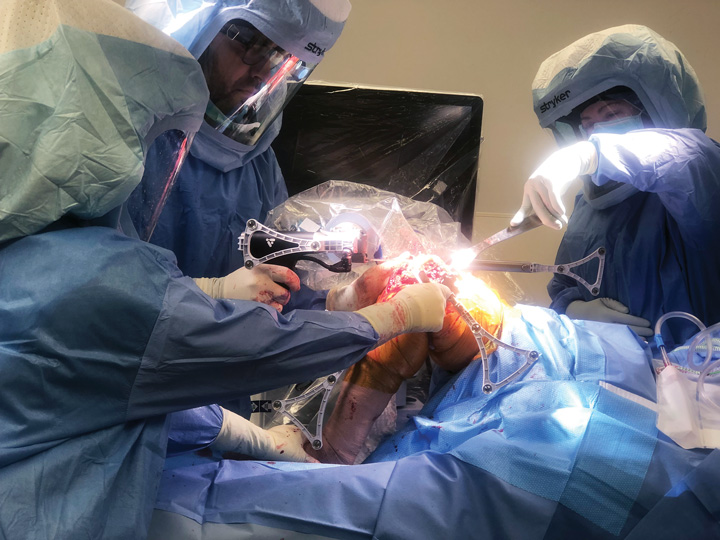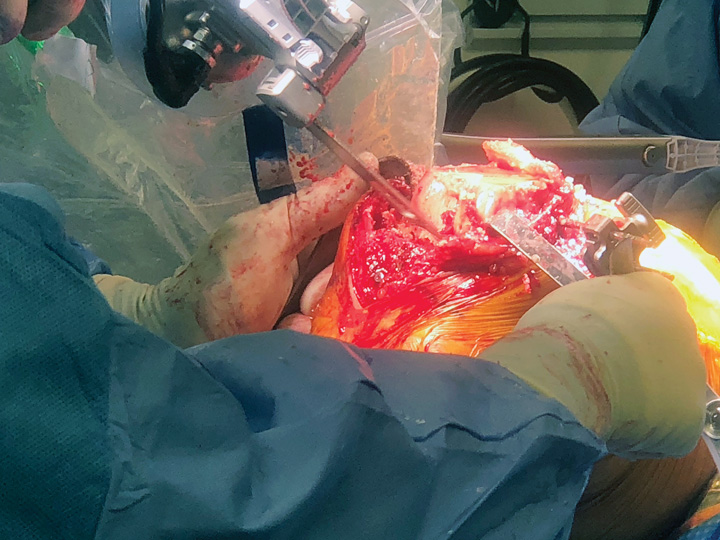- Home
- Special Editions
- Article
Keeping Up With Robotic Advances in Orthopedics
By: Jared Bilski | Editor-in-Chief
Published: 6/16/2023
The next level of joint replacement gives surgeons the tools to execute more precise, consistent and reproducible surgeries.
There are plenty of misconceptions about what robotic surgical systems can do for orthopedic surgeons and the patients on whom they operate.
To clarify and set the record straight, Kenneth S. Chakour, MD, FAAOS, likes to compare these robotic-assisted platforms to GPS navigation systems. “I know how to get home from clinic, but I check GPS every time I leave just to see what the best way is,” says Dr. Chakour, a board-certified orthopedic surgeon who specializes in outpatient total joint replacements for Fox Valley Orthopedics, with locations throughout Illinois. “That’s what the robot allows me to do — to establish my operative plan before I actually execute anything, so I know exactly what I’m going to get before I get it.”
Better data, decisions and precision
On May 9, 2022, Dr. Chakour performed the first robotic-assisted knee surgery replacement for Fox Valley. In doing so, he also became the first physician in the Western Illinois area to bring that procedure to an ASC. Today, he performs around 30-40 total joint cases per month and is on pace for 300-400 total joints cases this year. Although not all those cases are performed in the ASC, Dr. Chakour is a big believer in the vast and mostly untapped potential of robotics — especially in an ambulatory surgery setting. “I think that we’re starting to realize that in terms of pushing the envelope, robotics is allowing us to do a better job of surgery,” he says.
As bullish as Dr. Chakour is about the capabilities of the robotic platform, he’s quick to point out that it’s simply another tool in the surgeon’s rapidly expanding technological toolkit. “The biggest misconception is that the robot is doing the surgery,” he says. “In reality, I am in control of the robotic arm that assists in the surgery,” adding that the platform is simply replacing the guides that surgeons would use to perform their bone cuts.
For Cory Calendine, MD, a board-certified orthopedic surgeon specializing in hip and knee replacement at the Bone and Joint Institute of Tennessee in Franklin, robotics is all about improved precision and personalization. “Surgeons get better data about the individual patient, but the surgeon still ultimately makes the decisions based on that,” he says. To Dr. Calendine, who does the majority of his 600 annual joint replacements robotically, the platform makes an already good process even better in several key areas. “You get better data, you make better decisions, and you execute with better precision,” he says.

The precision both Drs. Chakour and Calendine rave about comes from the data provided by robotic platforms. The platform provides information that can help surgeons perform cuts to the millimeter, and operate less soft tissue dissection to the patients, something that can lead to faster recoveries. Dr. Chakour says the process of utilizing the data provided by his robotic platform comes down to gaps around the knee. “The robot gives me real time information in terms of how much of a gap there is — inside and outside of the knee — and that’s the real bread and butter,” he says. “What we try to do is match those gaps as best as possible throughout the arc of motion.”
The toughest part, says Dr. Chakour, is to avoid being crushed by the sheer amount of data at your fingertips. “The learning curve mainly revolves around the interpretation of data, knowing how to interpret it and not being overwhelmed because you get a lot of information from the robot,” he says. “When you get lost in the numbers — something I’m training other surgeons to avoid — you lose sight of your orthopedic training in terms of how to do a joint replacement or how to adapt and use the data to help you accomplish your goal.”
To avoid losing sight of the vast training and superior skill surgeons have obtained through non-robotic joint replacements, Dr. Calendine urges surgeons — especially the surgical leaders who equip facilities with these systems — to view robotics as a natural extension of what’s already being done. “We don’t ever want to get rid of all the solid principles that have worked, but we do want a better way to apply those principles,” he says. “Robotics is built on those foundational principles that we’ve been working on for years. Yes, it’s a major step forward, but it’s not something entirely different than what we’ve been doing — it’s just the next level.”
But can we afford it?

Many ASC administrators view robotic-assisted joint replacement as a hospital-based procedure and haven’t even considered bringing a robot to their center due to the exorbitant upfront investment required to purchase the robot.
But vendors have responded to that obstacle and come up with a variety of creative and affordable ways to make robots worthwhile for smaller centers. Just ask Dr. Chakour, who was heavily involved in the placement of the robot at his surgery center. “Our robot’s not costing us a dime,” he says. “The investment part has changed dramatically. There are a lot of things out there that the robotic companies are allowing you to do to make it much more feasible.” Essentially, by agreeing to use the implants from the robotic vendor, the cost Fox Valley pays toward implants ultimately goes toward paying off the platform — costs Dr. Chakour says his center would be paying regardless of the robot. “Since we’re using a vendor that requires us to use the company’s implants, it’s a mutually beneficial setup where they get more business when we get a robot and we’re paying it off as we go.”
In addition to the creative finance options available to the center, Dr. Chakour reminds facility leaders to keep in mind that the technology won’t impact patients’ wallets. “When I do a surgery with robotic assistance, we’re only billing for a total knee,” he says. “There’s no added cost to the patient. My experience has been that patients aren’t billed at a higher rate or expected to cover costs of a robotic-assisted surgery outside of the normal CPT codes we use for joints.”
For his part, Dr. Calendine acknowledges that the capital needed to purchase a robotic platform is more challenging than that of a traditional hospital, but points to an increased flexibility on the vendor side of things. “Now all the major companies in the robotic space are offering innovative financial models, value programs or pay-as-you-go and leasing models to help,” he says. But cost isn’t the metric facilities should focus on when it comes to robotics. “The issue here is volume,” says Dr. Calendine. “From a financial standpoint, we need to acknowledge that you want to entice people to come to your center.” By all accounts, a robotic platform is one helluva enticement for patients. In fact, Dr. Chakour frequently gets patients who seek him out specifically because of the robotics and he’s even had people sign up after originally having their joint replacement scheduled with another surgeon as a direct result of the robot.
Our robot’s not costing us a dime. The investment part has changed dramatically. There are a lot of things out there that the robotic companies are allowing you to do to make it much more feasible.
Kenneth S. Chakour, MD, FAAOS
The decade ahead
Both Dr. Chakour and Dr. Calendine are excited about what the future hold for robotics in the ASC space, and the latter believes robotics will be the standard of care for all joint replacements — in hospitals and ASCs — within the next decade.
Dr. Chakour feels robotics are simply another way for surgeons to circumvent the issues that lead to poor outcomes. “When we talk about surgery, there are no guarantees,” he says. “The best thing we can do is try to minimize those outliers. At the end of the day, robotics — and technology in general — are helping us do a more consistent, reproducible job.” OSM
.svg?sfvrsn=be606e78_3)
.svg?sfvrsn=56b2f850_5)